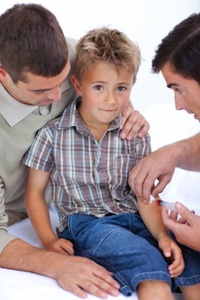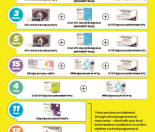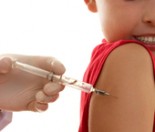Many children (and parents) find immunisation visits are an easy and relatively pain-free experience. For some children (and parents) however, needles can be scary, especially on the first visit.
Children can easily tell when their parents are anxious and, as a parent, you need to be aware that your child will look to you for comfort and reassurance.
What is the immunisation procedure?
The immunisations will be given at your family doctor’s rooms, usually by the practice nurse.
The injections are given in an arm or leg and if two injections are required they will be given in different places on the body – often one on each leg when the baby is quite young. Most vaccines are a combination of two or more vaccines to reduce the number of injections and clinic visits.
The nurse will ask you to wait in the surgery for 20 minutes after the injection, to ensure that your child does not suffer an allergic reaction called anaphylaxis. This is very rare and is treated immediately at the practice.
All children have an immunisation record of their own, which you will have completed each time your child is immunised, so remember to take it with you and keep it safe. It will be requested at various times, for example when your child starts school.
The staff will also record the immunisation on the computer for the New Zealand’s National Immunisation Register. This is an information system that holds the details of all immunisations given to children in New Zealand; this information can be used to help remind families when immunisations are due for their children and provide information on success of immunisation programmes.
What can I do to prepare my child for immunisation?
Before and during the immunisation
If unsure about your childs health at the time of immunisations, contact your GP’s surgery.
Cuddle your baby close and remain calm and matter-of-fact about the procedure. Feeding your baby may help, during or after the vaccination.
A toddler or young child can be prepared for injections in a calm and matter-of- fact manner. You may like to explain to them what is going to happen and perhaps demonstrate with a toy.
You could try bringing along a favourite toy or blanket for the child to cuddle.
It’s important that parents try to remain calm and relaxed as if you’re upset, this will only upset your child more.
You may like to offer some kind of treat for after the immunisation.
After the immunisation
After the injections soothe your child and after a minute offer some distraction such as a story. Many surgeries will offer your child a lolly as a treat afterwards which works wonders! (Have a quiet word with the nurse if you do not want your child to be offered a lolly).
Feeding a baby straight after the immunisation will help settle them.
Most children experience little or no ill effects after immunisations. Some of the minor effects reported are mild fever, tenderness or swelling and redness at the site of the injection. Here are some ways to make your baby or child more comfortable after their immunisation:
- Don’t rub the injection site
- Give your child lots of cuddles and lots of fluids
- If you are breastfeeding, give lots of feeds
- An ice pack wrapped well in a dry cloth or better still a cool cloth, can be held over the injection site if it is sore
- If your child gets hot, undressing them down to a single layer, for example a singlet and pants, can help
- Make sure the room is not too hot or too cold.
If your child experiences an unusual reaction to the immunisation, you will need to contact your doctor or hospital immediately.
Other Kiwi Families pages about immunisation
Risk and complications of immunisation
The New Zealand Immunisation schedule
Informed choice on immunisation
Useful Immunisation Websites
http://www.health.govt.nz/our-work/preventative-health-wellness/immunisation/new-zealand-immunisation-schedule – Information on the current immunisation schedule
The National Immunisation Advisory Centre website






